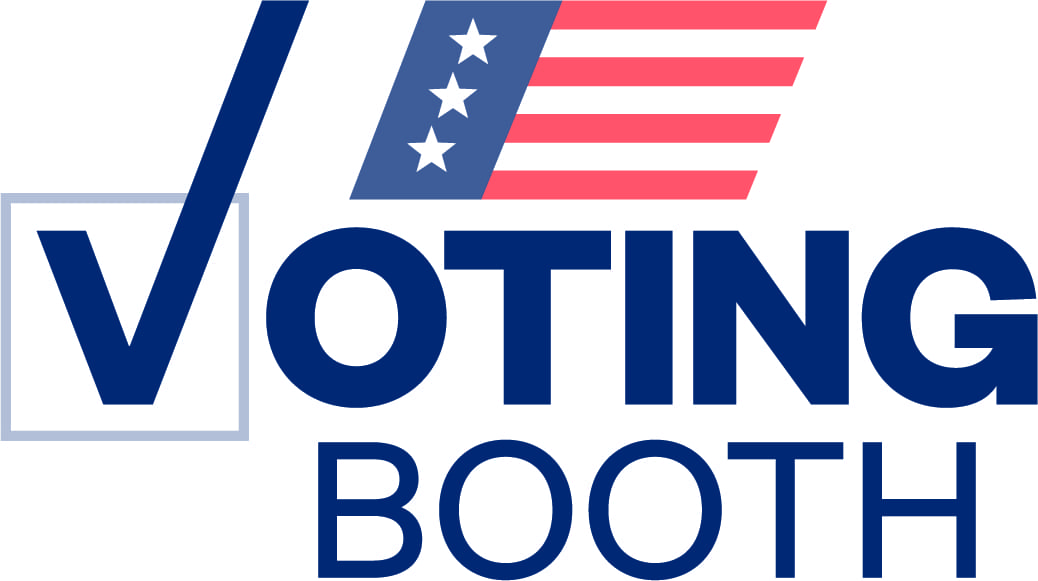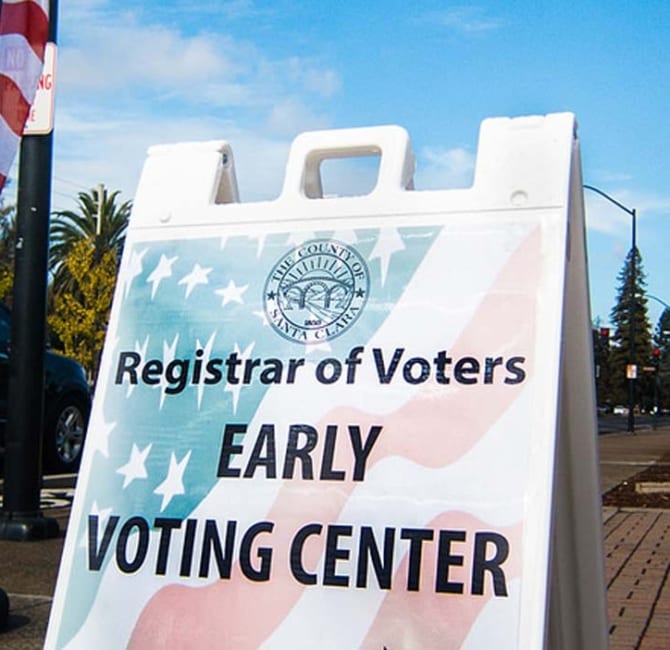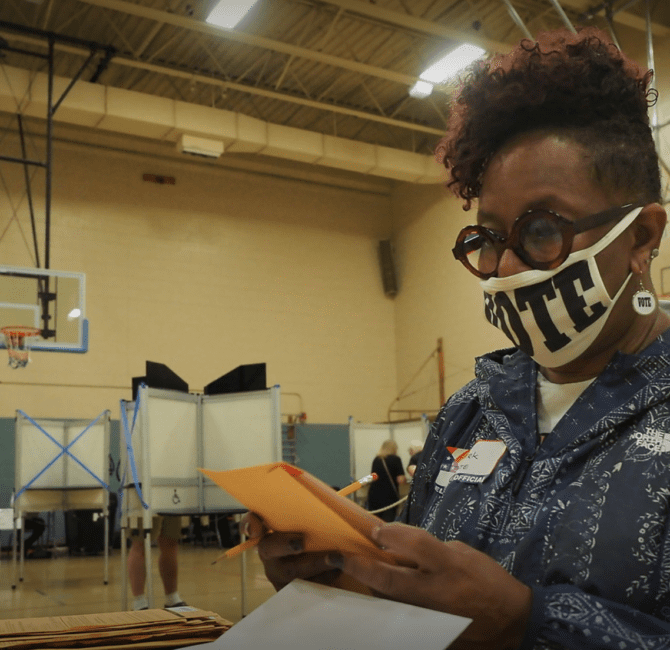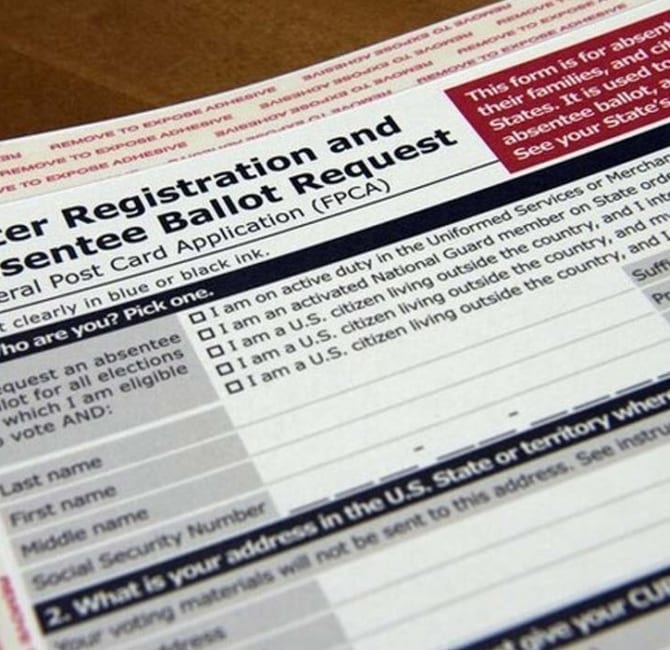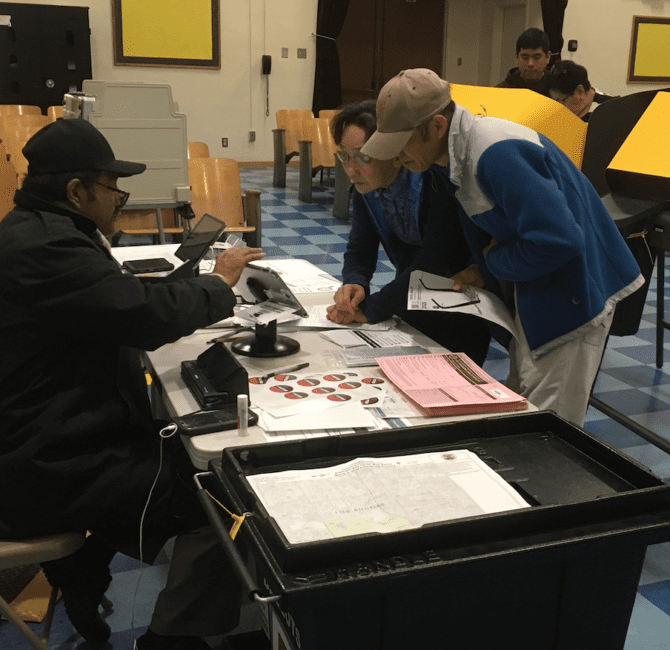With Such High Stakes This November, Here’s How to Make Sure Your Vote Is Properly Counted
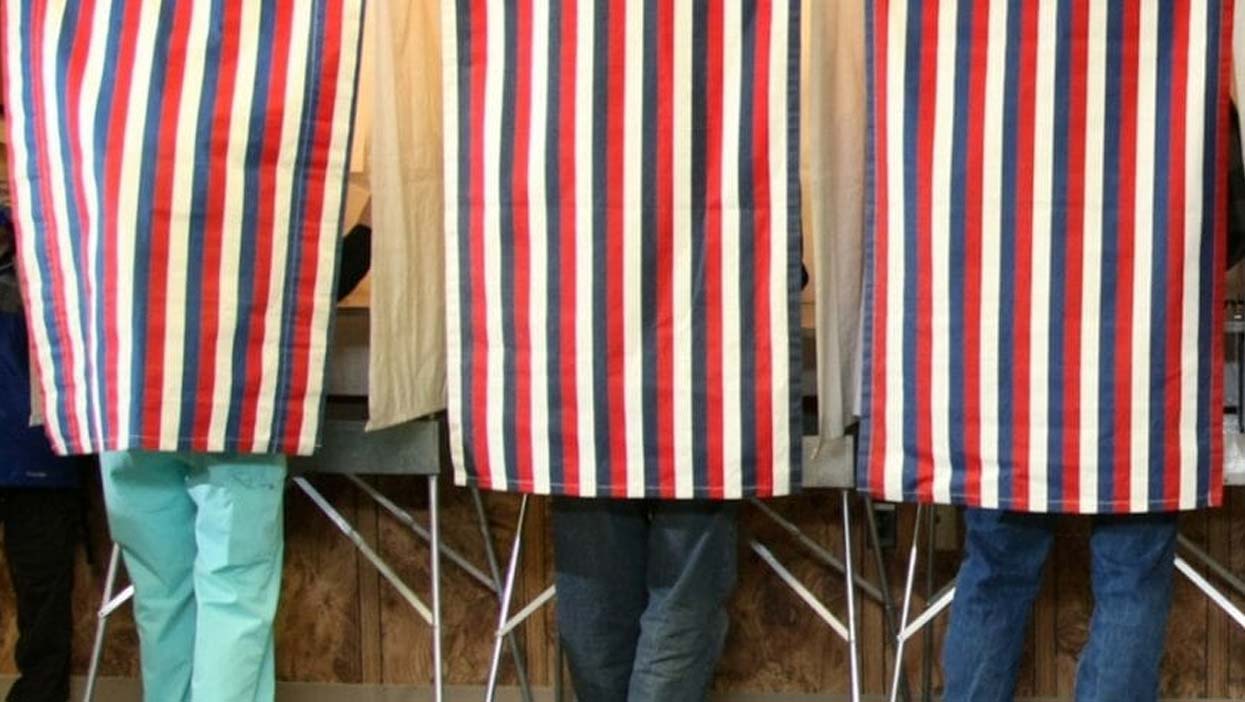
Editor’s Note: The 2018 midterm elections are quickly approaching. These non-presidential elections historically give voters a chance to change the country’s course. They will decide whether or not Republicans keep a majority in Congress, as well as determine important governor’s races and more.
A Voter’s Guide to the 2018 Election, written by Steven Rosenfeld, senior writing fellow of Voting Booth, is intended to help new voters, infrequent voters and veteran voters have a better idea of what they must do to be able to vote and have their vote counted. The following is an excerpt from the guide, available in full here.
Polling Place Issues
Sometimes voting is a breeze. You show up, sign in and vote, and that’s it. Other times it’s slow, delayed, confusing and chaotic. Either way, patience and some knowledge of the process is key.
People who vote in polling places and local precincts have a different experience than people who vote by mail (or vote early at county offices). In general, the biggest concerns for voting by mail is having the ballot envelope properly filled out and postmarked.
Voting at polling places is another story. Across America’s 6,467 election jurisdictions and 168,000 voting precincts, the experiences can really vary. There can be heckling by partisans on the street outside—or not. There can be lines and delays to check-in—or not. There can be informed poll workers (citizens nominally paid to run the process) at sign-in tables, or inside as precinct judges—or not. There can be voting machines that work—or not. There can be sufficient backup ballots and knowledgeable officials—or not.
Whether you are in a more functional or less functional polling place, the voting process is the same. So let’s go through it, especially for new voters. It starts with knowing when Election Day is. (That sounds obvious, but partisan disruptors have been known to tell people that their party votes on Tuesday—when Election Day is—and other parties vote on Wednesday.) This leads to a related point. You don’t have to stop or talk to anybody on the way into a polling place or while waiting in line. Political campaigns are legally required to keep a certain distance from the entrance.
Poll Location and Check-In
But let’s back up. You registered. That means you might receive, by mail, a voter guide with a sample ballot, which often includes statements from candidates, and pro and con positions on the non-candidate issues. That mailing also has one’s polling place location. Some states may only mail a postcard with the poll location. Voters who do not get this information should call their local election office. There are many polling place locator apps online, but it’s best to check directly with your local election officials.
On Election Day, give yourself enough time. (If you are going to be pressed, think about voting early if your state allows that.) When you get to your polling place, you have to check in. This is where you show your ID, if that’s required, or sign your name in a poll book, or sometimes both, and get a regular ballot. Then, you go inside, find a booth to privately mark a paper ballot or use a touch-screen computer, and turn in that ballot (in the folder given to you). Poll workers put the paper ballots into a scanner. You get an “I voted” sticker and you’re done. Voters with disabilities use special consoles.
What can go wrong? Well, every step of this process—for reasons that can range from simple human error, to poor planning by election officials, to bungling poll workers, to machines that malfunction, to rare but still real partisan power plays. In all of these cases, patience and perseverance are the key to casting a vote that will be counted.
Let’s start with long lines. Why would there be long lines? Maybe it’s a certain time of day and people are just showing up all at once. Maybe there are too many questions on the ballot and too few machines or voting booths, causing a voting traffic jam. No matter what, you have to be patient. Anyone in line will be allowed to vote, even if it’s past the official closing time. Check the weather. If it’s cold or wet, take a jacket and an umbrella.
Sometimes, long lines result from election officials making mistaken voter turnout estimates, as that translates into how many voting machines/booths are deployed. There is some chance that scenario will happen this fall, because midterm years usually are the lowest-turnout November elections. That’s mostly been true even in 2018, where there has been greater turnout by Democrats and less turnout by Republicans.
The Backup: Provisional Ballots
Once you’re inside, you have to check in to get a ballot. What happens if you know you have properly registered, but your name and street address are not in the precinct poll book? First, take a deep breath, and know there’s a process to fix this.
The first thing to check is if you’re in the correct polling place and precinct. (Many polls have multiple precincts.) If you are in the right location, but not in the poll book, you can re-register in states offering Election Day registration (see this list) and then get a ballot. If you’re not in one of those states, you will be given what is called a provisional ballot. (In 27 states, partisan “poll watchers” also can challenge a voter’s credentials, triggering a provisional ballot. That’s very rare, but we’ll get to what to do if it happens in a second.)
What is a provisional ballot? They are ballots combined with a partial voter registration form. A 2002 federal law requires every state to offer backup provisional ballots. A voter fills in some different identifying information (address, birthday, etc.—states vary here), so officials can verify your registration before counting your ballot. The most common reasons for issuing a provisional ballot are: voters showing up at the wrong precinct and demanding to vote; people who don’t have the required state ID; people not listed on a precinct voter roll; and people claiming they never got an absentee ballot in the mail. Provisional ballots also have been used as backup if electronic voting machines fail.
People filing provisional ballots have to make sure they are turned in at the right desk—for their precinct. In half the states, turning in a provisional ballot at the wrong precincts means it won’t be counted. This scenario has been called the “right church, wrong pew” problem: You’re in the right polling place but can’t turn it in at any table. The solution is asking the poll workers—and checking that they’re properly signed and turned in.
Most states make an effort to verify and count all of their provisional ballots. But that is not always true—because some states, like Georgia, will not count them if officials have not verified all of the voter’s registration information in three days following Election Day. In other states, like Illinois, voters might have to show up at election offices with additional identifying documentation within a week of Election Day for the ballots to count. Lots of people never make that trip.
Still, provisional ballots are the backup system in all 50 states. So if something goes wrong, despite being proactive with registering and having the right ID with you, fill them out carefully and turn them in. Chances are they will be counted more than not.
If, for some reason, a voter is having a problem with harassment while waiting in line, the precinct check-in process, or getting answers about provisional ballots, there are Election Day hotlines to call lawyers volunteering for a nationwide Election Protection project run by the Lawyers’ Committee for Civil Rights Under Law. That toll-free number is 1-866-OUR-VOTE (687-8683).
Election protection lawyers will tell you exactly what to do, and if necessary, are ready to go into court on your behalf. They will also alert the media about egregious problems, from harassment of voters to undue partisan challenges to any real breakdown in the process.
(In 2018, they are aware a federal court order that for the past 30 years has restricted the Republican National Committee from unduly challenging voters under a “ballot security” pretext—saying people signing in at polls must present additional credentials [usually more ID]—may be repealed. If that happens to you—call them. They will be on it.)
Voting Machine Issues
Once signed in, voters get a paper ballot in a folder and are directed to private booths to fill it out, or they go to electronic voting machines where they touch the screen to make their selections.
Voting machine technology is a controversial topic. But recently there’s more good news than bad with the voting machines used across America. Three-quarters of the country now votes on ink-marked paper ballots, and that figure is growing. Paper ballots are the best way to ensure there is a record of every vote cast. Scanners count these ballots, which can be further examined in recounts and audits. (The newest scanners even compile digital images of all the marked ovals race by race, which have helped to transparently resolve who has won very close contests.)
The bad news surrounds the oldest paperless voting systems, which still are used in 13 states—and entirely across five states (Louisiana, Georgia, South Carolina, New Jersey, Delaware). The biggest problems with paperless technology are that there is no backup in case the computer memory fails, and the vote counting software is susceptible to hacking, which has been shown to be a possibility in academic settings. (See this chart of voting technology by state and county.)
What does this mean for voters now? It’s counterintuitive, but the visible breakdowns on paperless machines are well known by now, as are their causes and fixes. For example, a decade ago, it was not uncommon for touch-screen users to select one candidate but see another candidate’s name appear. However frustrating it may be, the issues that have bothered activists and academics the most—hacking the results—are concerns voters cannot do anything about while they are using these machines on Election Day.
If you are voting on a touch-screen system and experience a problem, what do you do? You pause, ask poll workers for help, and either use another machine or insist on using a paper ballot backup. That sounds frustrating. Yet there is only so much a voter can do in that moment. You don’t have to be shy here. Voters make mistakes marking ballots all the time. Poll workers give them fresh ballots. They have a process for spoiled ballots. The pragmatic answer here is to speak up if something isn’t right with a machine.
With few exceptions in 2018, electronic voting machine breakdowns are not likely to be a major issue for most voters this fall. That conclusion even extends to the one threat that no voter can do anything about—the prospect of intentionally altered or hacked results. Why? Because since April, most states and the federal government have undertaken unprecedented cyber-security precautions surrounding the computers used in voting. Congress appropriated $380 million to secure these systems from Russian hacking. Ironically, it took a foreign power for election officials to take hacking seriously.
The Long View
The voting process has requirements, steps to be followed, potential bottlenecks and procedural hurdles, and backups if things go wrong. Those complexities raise larger questions, starting with, “Can voters trust this process?”
The answer is yes. We have to. We have no choice. Also, across America, most of the people running the nuts and bolts of elections are career civil servants dedicated to voting. They are not cut from the same cloth as politicians and political appointees who see elections as the pliable path to obtaining power. While there is some overlap, civil servants, as a profession and culture, believe in participatory democracy.
Despite the process’ pluses and minuses, voting is how citizens change or sustain our political system’s leaders. If the stakes in voting weren’t high, or if voting didn’t have an impact, you wouldn’t find all these political efforts in some states to make the process harder for the opposing party’s base.
As we look toward 2018’s midterms, the good news is that voting has become easier and more trustable in most of the country. That reality can be seen in more options to register, more ways to vote and wider use of paper ballots. In other parts of the U.S. where voting is more arduous, voters are not without help. When it comes to getting voter ID in states with stricter laws, non-profit groups are poised to help people. If there are Election Day instances of harassment or obstruction, civil rights lawyers can be easily and quickly reached. There are also fail-safe systems, especially provisional ballots, which, when properly filled out, will be validated and counted in most states using them.
To read the complete text of “A Voter’s Guide to the 2018 Election,” click here to view online, or click here view/download the full guide as a pdf.
Also Available on: www.truthdig.com

